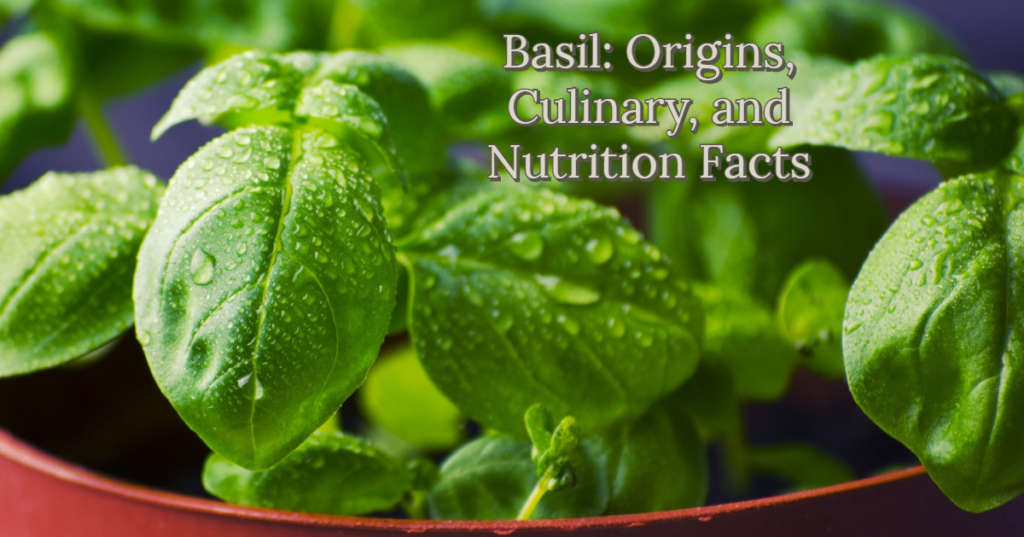
Basil is an herb that most people are familiar with and it is in the kitchen of almost anyone who cooks regularly. The botanical name for sweet basil (the most commonly used culinary variety) is ocymum basilicum and along with a few other familiar herbs like lavender, sage, and rosemary it is a member of the mint family (Lamiaceae).
Basil is one of the most common culinary herbs in the world. Partly because it can be used in so many ways. It can be used both fresh and dried and can be added to recipes ranging from pesto and pasta sauces, to seasoning stir frys and veggies, to being added in salads or sandwiches. The other reason that it is so prevalent is that it is used in dishes from most of the cultures of the world.
Origins of Basil
Originating in India and the Middle East, basil has been cultivated for over 4000, but it only spread to Western Europe when the spice trade began in earnest during the 16th century.
There are accounts of it being used in ancient Egypt, and it is believed that basil may have been part of the embalming process that the Egyptians used when creating mummies.
Basil has had a checkered past seemingly falling in and out of favor in different cultures. At times being considered holy, and at others as belonging to the devil. It has also been both considered to having strong healing properties, and conversely considered to be possibly toxic.
In India basil was a scared herb dedicated to the gods Vishnu and Krishna and often planted around temples. At one time it was placed on the chests of the dead to help ward of evil and help them in their transition into paradise.
In both Greek and Roman culture it was believed that in order for basil to prosper that farmers should curse as they sowed it.
During the middle ages in Europe basil was considered by some doctors to be poisonous. There are even accounts that it was believed that sniffing basil could cause scorpions to grown in the brain.
In France the herb is referred to as herbe royale, and in Italy it has often been used as a sign of love. Traditionally when an Italian woman placed a pot of basil on the balcony outside her room, this mend she was ready to be courted.
Some people believe that the name basil is derived from the ancient Greek work basileus, which means kind. Others believe that it comes from the basilisk, a mythical creature that could kill with it’s gaze.
Basil and Nutrition
Because basil is generally only eaten in small amounts it does not add significant nutrients to the diet, with the exception of Vitamin K. This herb is extremely high in Vitamin K so that even used in small amounts it provides a significant percentage of the recommended daily intake. Basil is also high in Vitamin A and Manganese but not enough so to give a significant gain with ordinary consumption.
Vitamin K is know as the clotting vitamin and is important in helping the body form blood clots and prevent excessive bleeding. Due to this consuming high amounts of basil or other Vitamin K rich foods can interfere with the effectiveness of blood thinning medications such as warfarin. Any concerns about this are something that should be discussed with your health professional or family doctor.
There has been some research done into the possible benefits of basil extracts but there is not enough evidence for definitive conclusions. Some of the possible benefits that have been observed are:
- Assisting in reducing stress and depression.
- Some antibacterial properties
- Repelling insects
Basil in the Kitchen
Basil is very well known for being used in tomato based sauces. It is also famous for pesto. Which is a beautifully flavored sauce made with basil leaves blended with olive oil and garlic. The uses of basil however are extensive and it will breath extra life into many recipes with it’s wonderful taste and aroma.
Fresh basil has a strong and unique slightly sweet flavor with hints of cloves and mint. Dried, basil does not have quiet the same taste, being somewhat less pungent and with a stronger taste of mint.
Basil has a special affinity for tomatoes and they pair together the way that apples pair with cinnamon. Used in pasta sauces, sandwiches, salads along with tomatoes you will know that basil is at home. It also shines as a topping on pizza or bruschetta, enhancing the flavors of tomato in a way nothing else does.
This herb can be used for more than just pairing with tomatoes however, and is wonderful when added to soups and stir frys. It works well when blended with garlic thyme or lemon, and in herb blends such as Italian seasoning. Basil is also great for adding a bit of extra flavor to more mild tasting vegetables such as zucchini, potatoes, cauliflower, squash, eggplant, and carrots. It complements mushroom dishes very well, and is a great addition to recipes using these.






